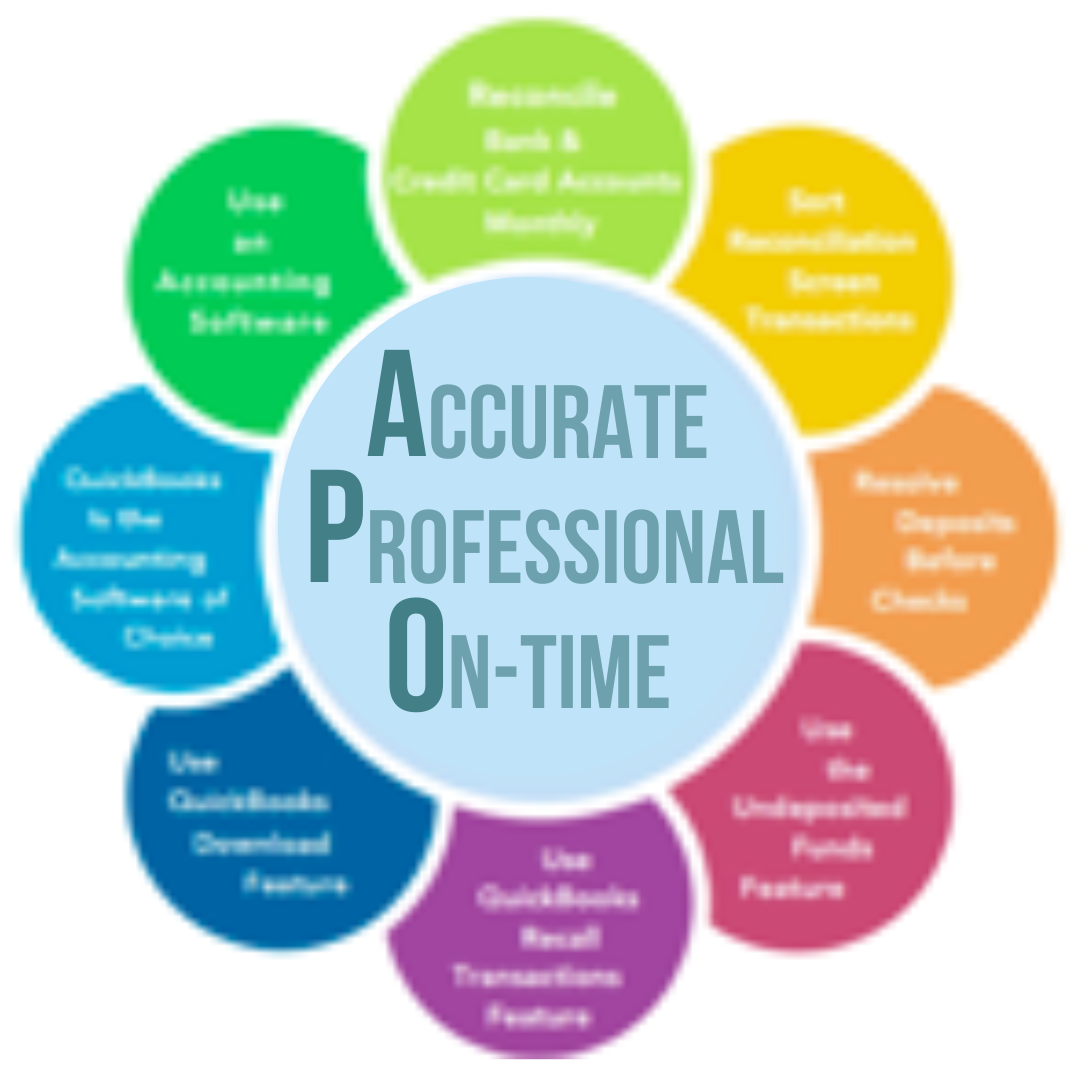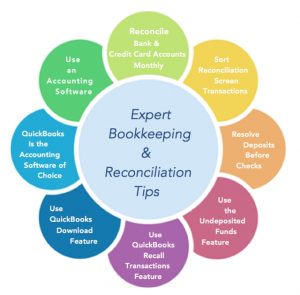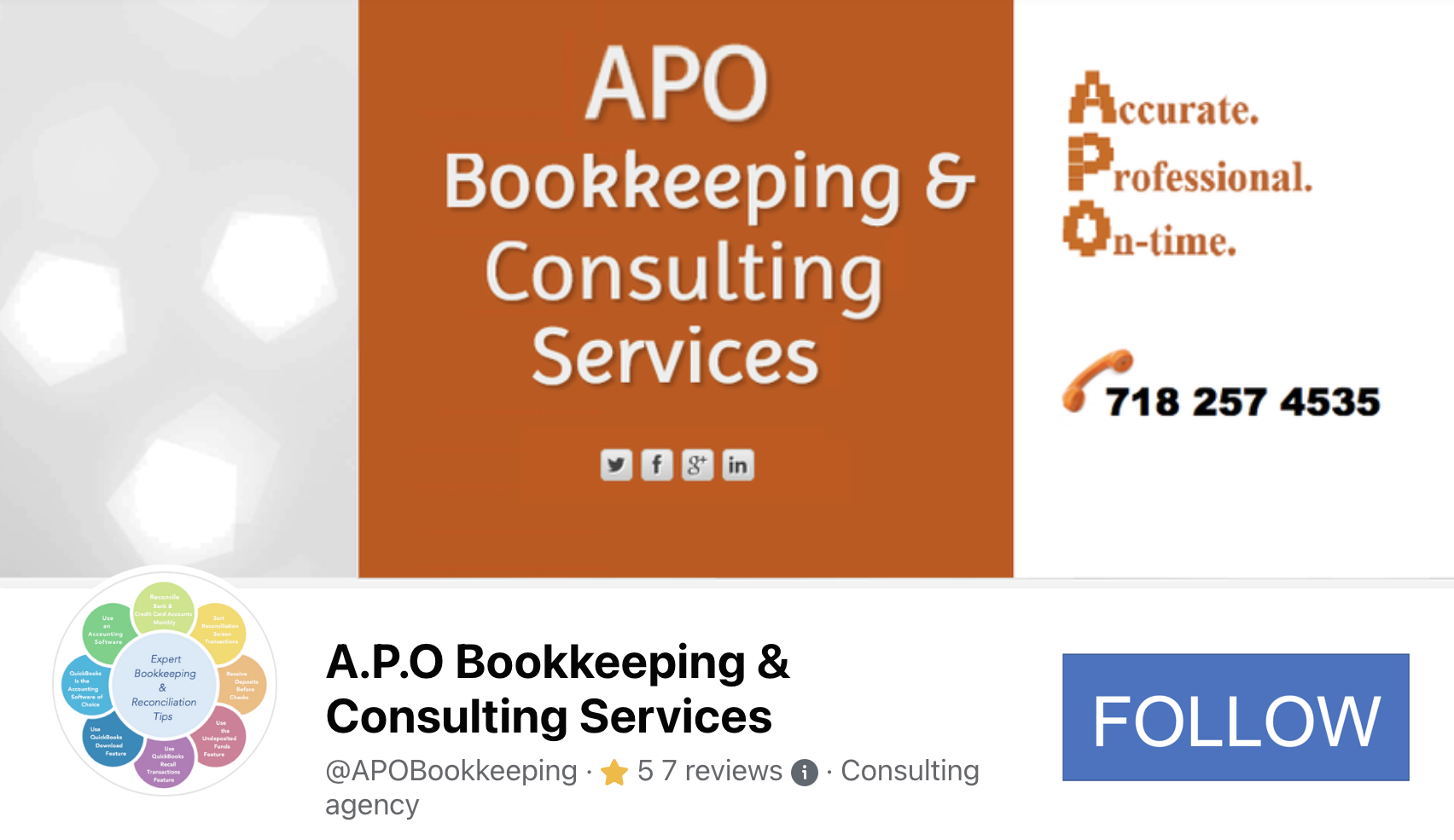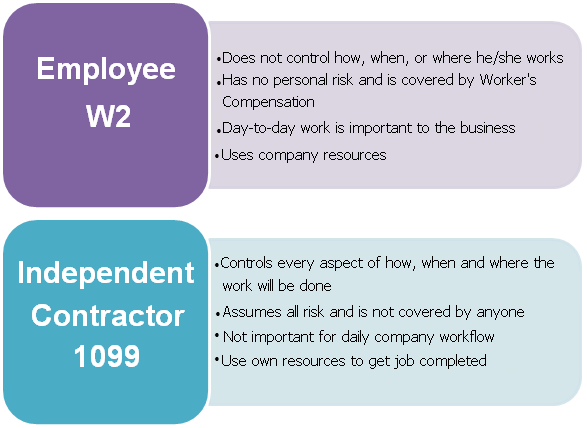
by Eugénie M. Nugent | Mar 31, 2015 | Business Tips
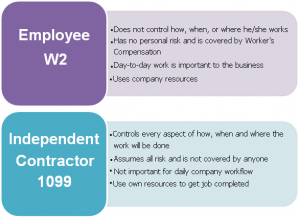 Many small business owners find it easier or more convenient to use independent contractors than to hire employees; but is the arrangement you have with a worker that of an independent contractor or that of an employee?
Many small business owners find it easier or more convenient to use independent contractors than to hire employees; but is the arrangement you have with a worker that of an independent contractor or that of an employee?
According to the IRS, there is a huge difference between an employee and an independent contractor, and they are adamant about doing all they can to ensure each is treated as who they really are by every organization. So how do they expect you to differentiate and treat each? Below are a number of key questions, based on IRS Guidelines, that when answered will lead you to the most suitable solution for your particular situation of who your worker should be – an employee or an independent contractor:
 How often does this person work for you? How regularly someone works for you is more important than how many hours they work for you. For example, an accountant who balances the books on a quarterly basis is definitely not an employee as is an assistant who comes in once per week on any day chosen by her, to catch up on the previous week.
How often does this person work for you? How regularly someone works for you is more important than how many hours they work for you. For example, an accountant who balances the books on a quarterly basis is definitely not an employee as is an assistant who comes in once per week on any day chosen by her, to catch up on the previous week.
 Do you set the person’s schedule? A key indicator of employment status is how much control you have and exercise over a worker’s schedule. Independent contractors set their own schedule, employees do not.
Do you set the person’s schedule? A key indicator of employment status is how much control you have and exercise over a worker’s schedule. Independent contractors set their own schedule, employees do not.
 Do you instruct or supervise the worker? While you are probably providing all workers with some guidance, how much control you have over their approach helps determine their status. Independent contractors listens to what you want to get done, but use their own approach to get it done. Employees are often told what, how, and when to do what.
Do you instruct or supervise the worker? While you are probably providing all workers with some guidance, how much control you have over their approach helps determine their status. Independent contractors listens to what you want to get done, but use their own approach to get it done. Employees are often told what, how, and when to do what.
 If additional workers are needed for a job, who hires them? The amount of control you have over a worker’s decision-making power is an important factor in determining their employment or non-employment status. Independent contractors are responsible to get the task they are given done and to hire help if they need to. Employees do not hire additional help, their employers do.
If additional workers are needed for a job, who hires them? The amount of control you have over a worker’s decision-making power is an important factor in determining their employment or non-employment status. Independent contractors are responsible to get the task they are given done and to hire help if they need to. Employees do not hire additional help, their employers do.
 Who provides the tools and materials necessary to complete the job? Employees use the company’s equipment and supplies; independent contractors provide their own.
Who provides the tools and materials necessary to complete the job? Employees use the company’s equipment and supplies; independent contractors provide their own.
 How is the worker paid? The timing and method of payment are important indicators of worker status. Employees are often on payroll, whereas independent contractors invoice for payment. If the person is paid regularly, he is most likely an employee. However, those who are paid only when a project is complete, or a sale is made, may be an independent contractor. (A bit blurry, but looking at the entire picture will dim the blur.)
How is the worker paid? The timing and method of payment are important indicators of worker status. Employees are often on payroll, whereas independent contractors invoice for payment. If the person is paid regularly, he is most likely an employee. However, those who are paid only when a project is complete, or a sale is made, may be an independent contractor. (A bit blurry, but looking at the entire picture will dim the blur.)
 Do you reimburse this worker for any business or travel expenses? Companies generally reimburse employees for expenses, while independent contractors pay their own to get the job or task complete and will add all expenses to their Invoice.
Do you reimburse this worker for any business or travel expenses? Companies generally reimburse employees for expenses, while independent contractors pay their own to get the job or task complete and will add all expenses to their Invoice.
 Can this worker’s decisions impact their own profits or losses? Independent contractors generally take on a degree of financial risk that employees do not. Renting an office, maintaining equipment, advertising and having multiple clients can all indicate profit-or-loss risk. Employees are risk free and are also covered with workers’ compensation.
Can this worker’s decisions impact their own profits or losses? Independent contractors generally take on a degree of financial risk that employees do not. Renting an office, maintaining equipment, advertising and having multiple clients can all indicate profit-or-loss risk. Employees are risk free and are also covered with workers’ compensation.
 Is this person hired to work indefinitely, or for a specific project or time period? How long someone works for you is one of the key considerations in determining employee status. Someone who works indefinitely is “probably” an employee. Someone who works on specific project or for a fixed time period may be an independent contractor. (This is where the lines start blurring for me.) If someone is working for me once per year and I want to have them working for me until I am out of business or he quits, then this person definitely does not sound like an employee to me even though he is working with me indefinitely. But again, looking at the big picture will minimize this blur.
Is this person hired to work indefinitely, or for a specific project or time period? How long someone works for you is one of the key considerations in determining employee status. Someone who works indefinitely is “probably” an employee. Someone who works on specific project or for a fixed time period may be an independent contractor. (This is where the lines start blurring for me.) If someone is working for me once per year and I want to have them working for me until I am out of business or he quits, then this person definitely does not sound like an employee to me even though he is working with me indefinitely. But again, looking at the big picture will minimize this blur.
 Are the person’s activities essential to your day-to-day business? The role a person plays in your broader business is a critical factor. If someone has to keep the business pumping such as a receptionist at a hotel, or a chef at a restaurant, then of course they are employees.
Are the person’s activities essential to your day-to-day business? The role a person plays in your broader business is a critical factor. If someone has to keep the business pumping such as a receptionist at a hotel, or a chef at a restaurant, then of course they are employees.
In short, if:
- You the employer control how, when, and where this person works, this worker is an employee.
- This person takes little or no personal financial risk, this worker is an employee.
- This person’s work is relatively important to your business, this worker is an employee.
- This person uses your resources – computer, printer, office supplies, etc., this worker is an employee.
The IRS has got to be one of the most complicated entities around. Nothing is ever black or white and the gray area seems to be endless. Yet, we all have to ensure we are in compliance with their many rules and regulations at all times. For this reason, it is usually a great idea to consult with a tax or legal advisor before deciding on any factor as it relates to the government taxing agencies.
Commonly Asked Question:
Can an Employee also be an Independent Contractor for the same company? The answer by Larry Shaub, CPA, CHRS, CPP of Accupay.
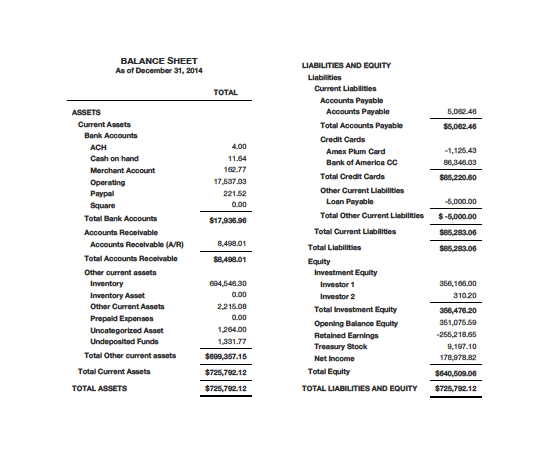
by Eugénie M. Nugent | Feb 28, 2015 | Business Tips, Financial Reports

Balance Sheet Example
- Assets
- Liabilities
- Equities
1) Assets – What You Own
Balance sheets usually start with cash balances that include monies presently in your bank account(s) as well as your petty cash till, minus checks you may have written but are not yet presented to your bank to be cashed. Those outstanding checks would reduce your account balance(s) once they are cashed. Monies in your Paypal, Square or any other ecommerce portals that allow you to receive payments are also shown in this section of your balance sheet.
If customers owe you money that you have invoiced for but not yet received, you will see those outstanding amounts in Accounts Receivable on your balance sheet.
If you sell products, the cost of all of them that you have purchased and not yet sold will be in the Inventory Asset account.
If you own equipment, furniture, vehicle or something similar that lasts for years, you will have a balance in Fixed Assets for what you paid for these items. If it has been a while since you have owned them, you may have a Depreciation account, and when you net the two, your Fixed Asset values are reduced.
All of the above are assets and they are listed in the first section of a balance sheet.
2) Liabilities – What You Owe
If you owe money for taxes, to vendors, or to employees, then it will show in the Liabilities section, which is the second of three major sections of a balance sheet. Day to day unpaid bills are in an account called Accounts Payable, and separate accounts are usually set up to document monies owing for taxes, etc.
If you have bank loans, they usually each have a separate account like a bank account does. Each bank loan account represents the principal due on a loan (the interest you pay is recorded in the expense section of the P & L).
3) Equities – All Monies You have Invested In Your Business Plus/Minus Its Income or Loss
The final section of the balance sheet is the Owner Equities. It is the section that will vary the most depending on the type of entity your business is set up as. For example, if your business is a corporation, there will be a common stock account that will represent the original amount of money you put into the business. It will match the Articles of Incorporation that you drew up when you incorporated. This amount will rarely ever change for the life of the business.
Also, there is usually an account called Paid-in Capital which is how much additional money you have put in or taken out of the company beyond the common stock balance.
A corporation will also have a Retained Earnings account. This reflects accumulated profit (or loss) through the years of operation.
If your business is set up as a partnership, the equity section will include an account for each partner that represents their balance in the firm, which is the net amount of money they have put into the business over the years minus the amount they have withdrawn as well as plus or minus the business income or loss through the years.
Unlike the Profit and Loss or Income Statement accounts that are zeroed out at the end of each accounting period, the balance sheet accounts accumulate continuously and does not clear out at the end of each accounting period or year. Thus, the P & L or Income Statement report can be generated using specified date range while the Balance Sheet report can only be generated as at a particular ending date and not by range of dates.

by Eugénie M. Nugent | Jan 12, 2015 | Business Improvement

Photo Courtesy of APO Bookkeeping
There is always room for improvement, and what better time to take stock, analyze, and set in motion the changes necessary to facilitate improvement than at the beginning of a new year. Here are five surefire things you can do to launch your business to new heights.
- Afford Your Business a Website (With a Blog)
- Formulate a better relationship with your Customers or establish one
- Gain New Customers by Marketing to Your Target Prospects
- Know your business trend. Know your numbers.
- Delegate tasks you do not do well, or enjoy doing
1) Afford Your Business a Website (With a Blog)
Your business is doing extremely well and you do not have a website. Awesome! Kudos to you! But guess what, there is always room for improvement, and your business can still do better. A business without a website and a blog is like an unpublished book; you have it but no one knows about it.
Unless you are Walmart, Staples, Home Depot or any other well established brand, operating a business without a website and a blog is futile if generating leads and having conversions is your goal for your business. The Internet is the number one place people turn to for information whenever they need to, and if you are not there you will not be found in their search results – even though your product and/or services may well be what they are looking for. You are missing out on the competitive edge! Adding a blog to your website is the best way to increase traffic to your website so more people can know about you and your services. The more visitors you get, the more leads you can generate. And the more leads you generate, the more business you will close.
- Write quality content
Of course, you need to write content that people will actually be interested in and want to read! Your goal here is to get publicity and ultimately gain conversions, but in order to gain more high quality leads you will need to put some quality time and effort into your blog construction and presentation. Write articles relative to your business on a regular basis and publish them. They do not have to be long and winding; quality over quantity is king any day! Don’t just slop something up in two minutes and call it a post, if you do not have time to write a decent post, don’t post anything at all. A bad, sloppy post can actually do your business more harm than good. Your blog represents you and your brand, so put some thought into what you publish. As Melinda Emerson the Small Biz Lady warns, “There’s no separating you from your business, and you have to brand yourself accordingly.“
- Promote Your Blog Posts
Now what purpose would it serve if you put all that effort into writing content that you think will be just what your prospects want, if you do nothing after writing them and hitting the publish button. None whatsoever! You must promote your blog content to social media sites, which is the only way anyone will know they are available and be able to read them. Apps, such as HootSuite, is a useful tool that allows you to manage multiple social media network accounts in one easy to use interface. You can schedule updates ahead of time, and publish across platforms at once, which is very convenient as it gets the word out on many platforms with minimal time and effort. With only 24 hours in a day, it is critical to make every minute count.
2) Formulate a better relationship with your Customers or establish one
Yes, you may have employees who are designated to various positions having direct contact with your customers, but in taking your business to the next level, you must periodically reach out to your customers and make a direct connection. There is a difference when a customer hears from a business owner than an employee. Connecting directly shows that they are valued, which puts you at an advantage where you can also gain valuable insight that can help enhance your business’ bottom line. This may not be practical for large companies with a broader customer base; however, they can devise an effective customer support team that will provide their customers with the best customer service possible. Your customers will let you know how satisfied or dissatisfied they are, at which point you can get to the drawing board and aim to please the disgruntled. As humans, we are built to want better, and as such we are always looking for ways to improve. Your customers are no different! They want the best customer service as well as the best product and service for their dollar, and will not hesitate to look elsewhere.
3) Gain New Customers by Marketing to Your Target Prospects
It has been said time and time again, and cannot be reiterated enough, how important it is to: 1) have a niche market, 2) know your target audience, and 3) develop strategies geared towards them. Marketing is a must if any business is to succeed. If done right, it will yield favorable but if done wrong, you will waste valuable time yielding zero results. Have a niche market so you know whom you are targeting. For example, if you are marketing to college students, you will have an idea of what to include in your marketing material, where to market, and when to promote your goods or services. Stop wasting valuable time and resources marketing to everyone, and cater to your target audience.
4) Know your business trend. Know your numbers.
Many small businesses that have closed their doors could have been around today had they kept score of their business’ numbers on a regular basis. They consistently operated at a loss, with minimal to non-existent cash flow, and yet failed to keep score of their daily, weekly, or at the very least – their monthly numbers. You should be improving, not declining. Keeping score of your numbers will allow for early intervention where you can identify areas that you can make improvement on and areas you can eliminate. Know what is taking place in your business with your business finances. Pay attention to your financials! Even though you may designate certain financial aspects of your business to enable seamless operation especially when you are unavailable, you should find a way to know that what should be happening is actually happening, and nothing more or less. You must have a firm understanding of your cash position every day, which can be accomplished by carefully managing and monitoring your banking relationship, and your books. Also, does your business require more funding at certain times of the year than others? Do you usually have down-time at certain times during the year? What will you be doing during that time? And, how will you maintain your business paying those overhead costs? These are some of the questions you should be able to answer at any given time.
5) Delegate tasks you do not do well, or enjoy doing
Even as a small business owner, there will be areas of the business that must be taken care of that is either not in your scope of knowledge or a part you enjoy doing. The latter will drain you emotionally and physically, and may even put a damper in your passion for your business. We are living in an era of technological advancement with software and information everywhere, and as such, many business owners looking to save on cash, are attempting to do it all by themselves, even without the skill base necessary. But mistakes can be costly, and in many cases there is only a very slim margin for error. You know your organization best, as well as your capabilities. Don’t waste valuable time mulling over subordinate or mundane tasks that you could otherwise designate! Take stock and delegate the tasks that are weighing you and your business down, and prepare to soar.
Implement the above-mentioned five changes and and watch your business flourish in an upward chain of improvement.
What are your thoughts? Feel free to express in the comment section below.

by Eugénie M. Nugent | Dec 1, 2014 | Engaging Employees

Photo courtesy of:
© Monkeybusinessimages | Dreamstime.com
I have witnessed firsthand where employees go from nonchalant to concerned, activated employees. For many employees, their only reason for going to the job is merely the paycheck. They have zero interest in the company and as such very lackadaisical, and this outlook sets the tone for unhealthy customer service, stifled employee relations, an unmotivated work environment, and a stagnant or declining business. This is not a situation any business owner would like their business to be a part of, and thankfully, there are ways to not only energize your employees, but also connect them to your business strategies.
5 Step Approach To Utilizing Employees Full Potential
- Activating and mobilizing your employees
- Creating and implementing strategies that are geared towards business success with a theme of employee involvement
- Empowering your employees
- Opening and aligning the channels of communication
- Re-examining protocols and promoting continued collaboration
Step 1. Activating and Mobilizing Employees
You activate and mobilize your employees by giving them a voice, clear roles to play, and incentives. Studies have shown that humans are more likely to be attentive and receptive when rewards are in play. Essentially, in order to boost employees interest you can offer incentives for participation in both internal as well as external surveys. Surveys can range from individuals view of operation to customer satisfaction, as well as their social group stance on matters that are important to the particular business.
Shift your thinking to inspire your employees to be active in something that is about them. Give your employees business cards. Employees will start to feel like a part of the organization and not just a commodity for the company, and this will solidify their new stance of the business, and activate a drive to see the business succeed. Each time they hand out their business cards, your company gains new prospects who could quite possibly convert to new customers. Your equipping them with business cards allow them to market your business indirectly, while having a sense of pride. Employee activation is just as important as traditional external consumer-focused efforts. More than a paycheck, employees desire a sense of purpose, pride, and impact.
Step 2. Implementing programs and surveys and directly Connecting Your Employees to Your Business Strategies
After you have clearly conveyed your company’s purpose to your employees, you can start implementing programs that links them to your business strategies:
- Host brainstorming sessions and allow your employees to participate. Bringing together different perspectives harmoniously is important to leveraging individuals’ collective talents.
- Invite them to write articles for company blog. You can rest assured they will be broadcasting to their social networks the awesome work they are doing contributing to their company who values their input, which in turn converts to indirect marketing for your business.
- Create monthly or quarterly internal newsletters showcasing how your employees have helped to improve the company over a period, and putting forth additional plans for impending months. Also, communicate upcoming opportunities to your employees in your newsletters, as well as in a face-to-face meeting setting.
- Implement a mentorship program that allows seasoned employees to mentor newly hired ones. This will again give them a sense of purpose to the company, and show that you trust and value them. You can create a template they should follow and give them space to test their own learning methods.
Step 3. Employee Empowerment: You Can, and I Trust You To
Employees desire to feel appreciated and valued. When employees are involved in the equation, they will feel respected and as such exude a sense of loyalty and care for the organization. Consulting with employees help to promote a healthy working environment where all involved in the organization can benefit. Employees are in the everyday happenings of the company and as such, experience issues firsthand concerning customer relations for retail businesses, as well as internal controls that affect the organization. Without co-operation between employers and employees the chances of coordinating a successful healthy business is non-existent. In addition to empowering your employees with confidence and trust, you can create programs that advance them professionally, and subsequently give them room to implement strategies learned. As business owners, we all have to ensure we are offering learning and development opportunities on the job, and challenges to promote growth.
Step 4. Communicating Effectively: Speaking With, In Lieu of Speaking To
Effective communication is essential for the smooth running of the organization; communication that is not one-sided, but all-inclusive and understandable. As one great writer wrote, “The single biggest problem in communication is the illusion that it has taken place.” We cannot assume communication has taken place, and in order to ensure it has, all parties must be attentively involved in the process and in a reciprocative manner. When you speak to someone, you do not listen. On the other hand, when you speak with someone you speak as well as listen which is effective communication. Also, as business owners, it is imperative to make one-on-one time to speak with employees to find out what is on their minds. Do they have ideas for improving the business, or ways to promote a better workplace? What do they want to accomplish professionally? When employees feel the company is responsive to their concerns, and values their input, their desire to participate and contribute increases substantially. Improving interactions among employees as well as with management will strengthen morale, build team spirit, increase productivity, and create a cohesive, motivated workforce.
Step 5. Re-examining protocols and promoting continued collaboration
Based on company’s performance over a quarterly, biennially, or annual period, and employees feedback, reexamine issues affecting the company that can be changed and areas that can be improved. Foster a community of committed employees, and take all the steps necessary to promote continuous collaboration, and avoid complacency.
Setting an operational plan without consultation with employees disadvantages the organization because: 1) Lack of consultation fails to take advantage of all available knowledge and expertise and 2) Lack of consultation is most likely to make people feel left out which sets the tone for reluctance and negativity towards the emerging plan. Because employees are on the front line, they will affect the core of your business – your customers. Given the right atmosphere in which they feel valued and needed, they will exude confidence in their ability and it will shine through to the customers. What you will have is an employee-driven workplace with revitalized employees geared towards enhancing your company’s growth and development – collectively.
Your employees can make all the difference when it comes to growing your company. They produce, deliver, and manage your products and services day in, day out. This is why your HR strategy should include opportunities for training and recognition programs that keep your employees stimulated, strategic employees involvement programs, and clear cut communication channels which will all work together to keep your company thriving. Employees are really a reservoir of resource. Tap into them and watch your business grow.
What are your thoughts? Feel free to express in the comment section below.

 Many small business owners find it easier or more convenient to use independent contractors than to hire employees; but is the arrangement you have with a worker that of an independent contractor or that of an employee?
Many small business owners find it easier or more convenient to use independent contractors than to hire employees; but is the arrangement you have with a worker that of an independent contractor or that of an employee? How often does this person work for you? How regularly someone works for you is more important than how many hours they work for you. For example, an accountant who balances the books on a quarterly basis is definitely not an employee as is an assistant who comes in once per week on any day chosen by her, to catch up on the previous week.
How often does this person work for you? How regularly someone works for you is more important than how many hours they work for you. For example, an accountant who balances the books on a quarterly basis is definitely not an employee as is an assistant who comes in once per week on any day chosen by her, to catch up on the previous week. Do you set the person’s schedule? A key indicator of employment status is how much control you have and exercise over a worker’s schedule. Independent contractors set their own schedule, employees do not.
Do you set the person’s schedule? A key indicator of employment status is how much control you have and exercise over a worker’s schedule. Independent contractors set their own schedule, employees do not. Do you instruct or supervise the worker? While you are probably providing all workers with some guidance, how much control you have over their approach helps determine their status. Independent contractors listens to what you want to get done, but use their own approach to get it done. Employees are often told what, how, and when to do what.
Do you instruct or supervise the worker? While you are probably providing all workers with some guidance, how much control you have over their approach helps determine their status. Independent contractors listens to what you want to get done, but use their own approach to get it done. Employees are often told what, how, and when to do what. If additional workers are needed for a job, who hires them? The amount of control you have over a worker’s decision-making power is an important factor in determining their employment or non-employment status. Independent contractors are responsible to get the task they are given done and to hire help if they need to. Employees do not hire additional help, their employers do.
If additional workers are needed for a job, who hires them? The amount of control you have over a worker’s decision-making power is an important factor in determining their employment or non-employment status. Independent contractors are responsible to get the task they are given done and to hire help if they need to. Employees do not hire additional help, their employers do. Who provides the tools and materials necessary to complete the job? Employees use the company’s equipment and supplies; independent contractors provide their own.
Who provides the tools and materials necessary to complete the job? Employees use the company’s equipment and supplies; independent contractors provide their own. How is the worker paid? The timing and method of payment are important indicators of worker status. Employees are often on payroll, whereas independent contractors invoice for payment. If the person is paid regularly, he is most likely an employee. However, those who are paid only when a project is complete, or a sale is made, may be an independent contractor. (A bit blurry, but looking at the entire picture will dim the blur.)
How is the worker paid? The timing and method of payment are important indicators of worker status. Employees are often on payroll, whereas independent contractors invoice for payment. If the person is paid regularly, he is most likely an employee. However, those who are paid only when a project is complete, or a sale is made, may be an independent contractor. (A bit blurry, but looking at the entire picture will dim the blur.) Do you reimburse this worker for any business or travel expenses? Companies generally reimburse employees for expenses, while independent contractors pay their own to get the job or task complete and will add all expenses to their Invoice.
Do you reimburse this worker for any business or travel expenses? Companies generally reimburse employees for expenses, while independent contractors pay their own to get the job or task complete and will add all expenses to their Invoice.  Can this worker’s decisions impact their own profits or losses? Independent contractors generally take on a degree of financial risk that employees do not. Renting an office, maintaining equipment, advertising and having multiple clients can all indicate profit-or-loss risk. Employees are risk free and are also covered with workers’ compensation.
Can this worker’s decisions impact their own profits or losses? Independent contractors generally take on a degree of financial risk that employees do not. Renting an office, maintaining equipment, advertising and having multiple clients can all indicate profit-or-loss risk. Employees are risk free and are also covered with workers’ compensation. Is this person hired to work indefinitely, or for a specific project or time period? How long someone works for you is one of the key considerations in determining employee status. Someone who works indefinitely is “probably” an employee. Someone who works on specific project or for a fixed time period may be an independent contractor. (This is where the lines start blurring for me.) If someone is working for me once per year and I want to have them working for me until I am out of business or he quits, then this person definitely does not sound like an employee to me even though he is working with me indefinitely. But again, looking at the big picture will minimize this blur.
Is this person hired to work indefinitely, or for a specific project or time period? How long someone works for you is one of the key considerations in determining employee status. Someone who works indefinitely is “probably” an employee. Someone who works on specific project or for a fixed time period may be an independent contractor. (This is where the lines start blurring for me.) If someone is working for me once per year and I want to have them working for me until I am out of business or he quits, then this person definitely does not sound like an employee to me even though he is working with me indefinitely. But again, looking at the big picture will minimize this blur. Are the person’s activities essential to your day-to-day business? The role a person plays in your broader business is a critical factor. If someone has to keep the business pumping such as a receptionist at a hotel, or a chef at a restaurant, then of course they are employees.
Are the person’s activities essential to your day-to-day business? The role a person plays in your broader business is a critical factor. If someone has to keep the business pumping such as a receptionist at a hotel, or a chef at a restaurant, then of course they are employees.
